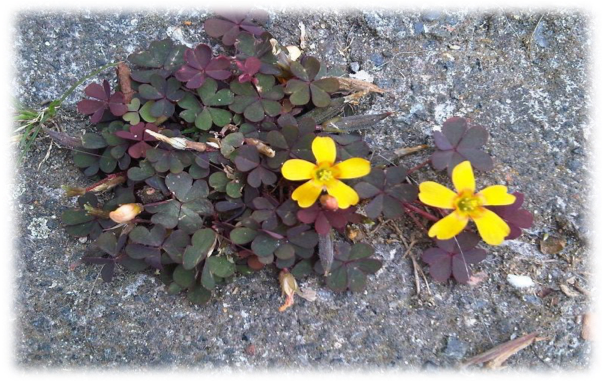Region
Thompson Shuswap
HOW TO IDENTIFY?
- Each leaf has 3 heart-shaped leaflets.
- Leaflets fold in half at night or when stressed.
- Small yellow flowers with five petals.
- Often confused with BLACK MEDIC or CLOVER – these don’t have heart-shaped leaflets.
HOW DOES IT GROW?
- An annual in most parts of Canada; a short-lived perennial in parts of BC.
- Mainly spreads by seed. Seed capsules EXPLODE, scattering seed up to two
metres away! Seeds need light to germinate.- Stems can also root at the nodes.
- Likes moist soil and partial shade and often grows through other plants (it’s hard to spot).
- Found in lawns, gardens, and greenhouses.
IS IT A PROBLEM?
- NO. It’s an edible weed, with a slightly sour, lemony flavour.
- It’s high in vitamin C.
- BUT BE AWARE that it (like spinach and
many other edible plants) contains oxalic acid.- It should NOT be consumed in LARGE QUANTITIES by people or livestock, especially people with kidney stones, rheumatism, or gout.
- YES. It spreads aggressively and competes with other plants.
HOW TO CONTROL?
- Hand pull it, making sure to get all the roots.
- OVERSEED lawns.
- Cover the ground in gardens with mulch, to prevent seeds from germinating.
- In new garden beds, soil solarization can be used to control it.
Sources:
Royer, F. and Dickinson, R. Weeds of Canada and the Northern United States. 1999 University of California Statewide Integrated Pest Management Program Agriculture and Natural Resources. Pest Notes: Creeping Wood Sorrel and Bermuda Buttercup. June 2010.
Image: Emőke Dénes. CC BY-SA 4.0, https://commons.wikimedia.org/windex.php?curid=21915084
PDF
| Attachment | Size |
|---|---|
| WOOD SORREL_0.pdf | 101.26 KB |
